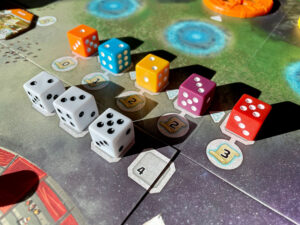 They came from the stars. Who exactly? Well, the Builders from out there in the galaxy. They’ve pointed to a star cluster, but we’ve been unable to spot it in the night sky while their motherships hover above our humble villages. The resulting illumination nearly blinds us if we look up for too long.
They came from the stars. Who exactly? Well, the Builders from out there in the galaxy. They’ve pointed to a star cluster, but we’ve been unable to spot it in the night sky while their motherships hover above our humble villages. The resulting illumination nearly blinds us if we look up for too long.
They chose us. Why exactly? We originally thought it was because of our connection to this earth, to the rich soil, the fertile valleys, and rivers. Or maybe because we have deeply rooted rituals that delight them. But rumors reach our ears that it may be due to our limited capacity for advancing our civilization beyond the hunting and gathering we enjoy so much. Yet we ask ourselves, do we really need parlors and temples to be better humans?
The Builder’s influence spreads. And now they are ready to influence you, too. Origins: First Builders is a dice placement and euro civilization game designed by Adam Kwapiński and published by Board & Dice. One to four players can become an Archon to assist alien races in bettering humanity’s prospects.
Gameplay Overview:
Players begin with a leader, called an Archon, one of each resource type as well as a palace and agora building. They draft two starting dice from a pool of color and value options. The five main color types utilized during play are blue, orange, purple, red, and yellow. These colors are important in all decisions made throughout.
The mainboard features five distinct areas that are all influenced by the sixth main area, which features encounter sites connected to a uniquely colored mothership dial. These mothership dials begin at value one and increase their value each time a site is visited by either a die or an Archon. The dial value is the only restriction for each encounter site, as many dice/Archons can occupy the space at the same time. But as the dials increase, a player’s die value must be equal to or higher than the value, or they must pay wisdom to make up the difference to use the site.

On a player’s turn they can choose from several options:
- Visit an encounter site with either a die or Archon
- Close a city district with an available die
- Build a tower level on their palace
- Grow their population
Each encounter site features two possible site actions, as well as a bonus action in the color of the mothership that is only activated by a matching-colored die. A die value between one and five can choose one of the two site actions, whereas a value six can choose both. Archons have no value (and thus no placement restriction) and begin the game with no associated color, though they gain colors as they begin to collect advisors later.
Many actions are available and range from gaining resources, to moving up military or zodiac tracks, to purchasing a new building or gaining a new citizen or speaker die. Each of these options provides new avenues to increase actions efficiency and build a better civilization. Players may forego placing a worker by spending gold to increase their palace tower levels or taking an available die to become a “seat of power” in the space between four adjacent building tiles in a player’s city tableau.

When a player decides to close off a district by making a die into a seat of power, they have the option to activate all buildings surrounding that die that match the color. As such, players may be able to activate building powers more than once during a game. At this time players also evaluate if their new district arrangement matches any of the district cards randomly chosen during setup. Players can gain gold and points by fulfilling these district requirements.
Buildings and citizens come at a price. Both options require wisdom. Beyond this resource, buildings feature a stone cost. Upon purchase, a building is added to a player’s city and the building’s unique power activates. Alternately, a new citizen die requires an available population base. Player’s start with two of these and can purchase more by spending food from their supply.
At the end of the round, Archons and player dice are returned to their boards. All dice have their value increased by one, to become more powerful for the next round. When a six value die is returned, it must either become an advisor to the Archon, or if a similar color advisor is already in place, it’s discarded for points equal to the number of advisors already in use. The military and zodiac tracks are also evaluated and may change player order and zodiac card distribution.

Game Experience:
We broke the game the first time we played it at two players. We reached one of the four end game triggers in the second round and looked at each other and said, “this can’t be correct.” But it was, as confirmed via the BGG forums, and we had to immediately adjust the ruleset suggested in the forums to allow for our style of play.
But I’m jumping ahead a bit. I really enjoy certain elements of Origins: First Builders. I think the mothership dials, while lacking production polish, provide a unique restriction to worker placement. They deliver some frustration along the way, but demand that players plan their moves with others in mind. The idea of the Archon worker is also fun—rather than being another dice that upgrades, it becomes an entirely unique being on its own. It also provides depth by asking players to diversify their dice colors, which can be restrictive based on their value when they appear on the board.

Other positives are the zodiac cards gained while being at the top of their respective tracks, which give players something to jostle over, as well as the white speaker dice that provide round specific worker placement benefits like the black dice in The Voyages of Marco Polo (2015, Simone Luciani and Daniele Tascini). The city building can also be crunchy and gives a civ game feel to what is a typical euro affair. And it’s nice that the design allows for each color to be always represented in the building and citizen areas.
But, ultimately, there is a lot of thematic depth that never enters the design space. The zodiac tracks provide a unique scoring mechanism (score the lowest two) but are incredibly boring to pursue. The military track feels the same way, as it provides some resources and a lot of points but overstays its welcome with superiority tokens that feel tacked on for no reason other than to make the pursuit more appealing. Both feel disconnected from the rest of the game and it’s a shame there wasn’t a way to combine them into a more thematic element.

Another area that doesn’t quite work is the district card options. Each district card features a unique loadout of tower tokens and a pattern that players seek to recreate. Rather than leave it at that, the rulebook states that the pattern can be repeated multiple times, as well as rotated or mirrored. The lack of restriction here is also present with the four end game triggers that players must constantly monitor rather than having a set round structure in place.
Sadly, very little of the actions being taken here feel like they are influenced by an alien civilization. Sure, there are motherships floating around at the top of the board, and yes the player boards feature nice artwork of diverse alien beings (that look human). Yet the benefits they provide feel too grounded in Earth, so much so that Origins creeps much closer to a standard euro civ game and not the advanced tech utopia it’s flaunting on the cover.
The other area I’d like to briefly include is production quality. Origins features poor color choices. The yellow and orange dice and discs are so hard to distinguish under the wrong light, that it hinders the game for some individuals. The motherships feel unfinished (many content creators have had to fill these in on their own to make them visible onscreen), and the gold and food resources look similar. All large misses that should’ve been addressed during preproduction.
Final Thoughts:

It’s official. Our new alien overlords have brought massive change to the land. They’ve made our leaders more powerful, provided action scarcity and resource bottlenecks, and added a lot of hustle and bustle to our typically relaxing way of being. We still long for earlier days, before they came, but catch ourselves marveling at the newest obelisks constructed in brilliant marbles or stunned by the amount of production churning from new granaries and quarries. Our population grows at a stunning rate, faster than we ever imagined, so there’s that to consider as well. But the feeling will never leave us that we’ve entered a new world that doesn’t quite work for our kind. We’ve no idea what the Builders really want. We’ve no idea why we continue to appease their demands. But we know we must carry on, for we are in too deep and there is no turning back now.
The design of Origins: First Builders gives me a similar feeling. It makes me wonder if the need to produce a thematically disjointed effort with a tweak on familiar mechanisms outweighed the pursuit of simplicity and narrative cohesion. I entered wanting to embrace the narrative but found each element hindered by a lack of imagination. While there are certain areas that hint at innovation, the overall direction holds this product back from being as advanced as the Builders’ ambitions.
Final Score: 2.5 stars – Thematically ambiguous dice placement with interesting ideas outweighed by design and production woes.
 Hits:
Hits:
• Mothership dial restrictions
• Evolving civilizations
• Archon advisor growth
Misses:
• Poor color/resource choices
• Zodiac trackzzzzz
• End game triggers
• Districts too flexible























I’m glad you posted this, as I had invested some time into designing a game about the archons (alien world-seeders that seem to have unfortunate plans for humanity). Your comments will be useful cautions if I return to that project.
😉 Question: Do you know of any other games about archons that do a really good job of integrating the theme of world-seeding with the mechanics?
There are plenty of colonization games, but I’m not sure of any excellent examples of a world-seeder with manipulative plans for humanity. Thanks!